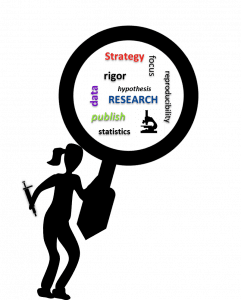Research may well be a creative, fluid and dynamic field, but structure and high standards are required to ensure that the findings generated by the field are reproducible, and not a waste of time and money, both of which are limiting factors in academic science. When I first started my career at the lab bench as a PhD student, I was not aware of this structure and its significance. Here I outline and describe the three important lessons that I learned in order to carry out successful research projects and publish my work.
Focus: I was a voracious reader; an eager sponge, I constantly soaked up information through literature review and my scientific thought process bolted off in a million different directions. After years of being restricted by the the extremely didactic learning system in India, it was easy to be carried away by the exhilarating liberty granted to me by my PhD advisor during independent dissertation research in the US. During this period, I learned my first lesson of designing a research project: Focus. While it is a good idea to keep abreast of the bigger picture, young researchers must reign in their scientific thought process and delineate the most testable hypothesis through literature review. Not all directions are viable or easily testable and “fishing expeditions” in lab while interesting for the sake of curiosity can often lead to nowhere. The key is to write down at least 2-3 main hypotheses, fairly open ended but specific enough to be tested through experimentation. Every grant application requires a section called Specific Aims. This section determines the substance of your thought process and the feasibility of your approach. Formulating a clean and testable hypothesis is an art perfected over time and facilitated by reading successful grant applications and published studies.

Strategy: The second lesson I learned was during experimental planning as I struggled to identify the tools I would need to answer the questions my hypothesis posed. Selecting the most appropriate investigative methods and research tools is crucial to scientific pursuit. In current times, when high-throughput analysis and kits to test several functions have become available, it is a special challenge for young researchers to not let techniques drive their research. Research should ideally be driven by a rational thought process, clearly defined hypotheses and a fair idea of various anticipated results, unless of course the goal of the research is to develop a new method. So my second lesson was: Strategy. Experimental design and strategy should be based on the nature of research inquiry and should start by enlisting the variables being tested and identify if the analysis is quantitative/qualitative/comparative/manipulative./correlative in nature? In Current Protocols, we have our authors describe their “Strategic Plan” so that users have a clear understanding of the rationale for why the method was chosen and how the method was designed. Every successful experiment has 3 main qualities: 1. It can answer multiple questions in one experimental run 2. It has the right controls to simultaneously eliminate experimental artifacts and demonstrate technical competence of the method and 3. Resulting data will ideally lead to the next question.
Rigor: The third lesson is relevant to all scientific pursuits: Rigor. Experimental rigor defines the reliability and value of your findings. To ensure rigor, researchers should follow these rules: 1) Always repeat the experiment, using the same exact parameters, at least 3 independent times and using several internal replicates (when in doubt, repeat) 2) Always refer to an original protocol and make note of any modifications, no matter how minor (Current Protocols can help you with this) 3) Always ensure that any new methods are standardized and validated using known outcomes. At Current Protocols, we ensure that the step-wise guidelines detail the number of times the experiment was repeated and what controls were used. Rigor and strategy, collectively are of particular relevance to troubleshooting and optimizing (T&O), the activities that constitute a good majority of life at the bench. During T&O, most researchers find themselves repeating experiments to identify or fine tune the steps or reagent/s that affect experimental results. In doing this, it is imperative to test one parameter per experimental set and make sure negative and positive controls for that parameter are included. If you change multiple parameters in the same experimental set, you will not be able to identify the exact step or reagent that caused the experiment to fail.
Statistical analysis has always been an important aspect of data analysis and even more so in recent years with the arrival of big data outputs and the merging of technology with the generation and evaluation of research outcomes. Researchers often see modest differences between data sets and statistical analyses help tease out or rule out differences. Identifying the correct statistical analysis approach is key towards arriving at scientifically sound conclusions. Data validation and analysis by statistical analysis rests on the rigor and experimental strategy of the experiment. Accurate statistical analysis requires comparisons between various controls and hence including as many useful controls in the original protocol is advisable to avoid the pain of having to repeat experiments solely for statistical analysis. Current Protocols ensures that authors detail the statistical analysis used for the method so users can embark on a well-informed scientific plan from the get-go.
The tenets listed above can determine the ultimate quality and value of a researcher’s findings to the field as a whole. Research is expensive and time consuming. So make sure you do it right.
For updated, detailed, step-wise protocols, visit Current Protocols.

















